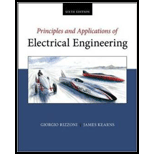
Concept explainers
A free electron has an initial potential energy perunit charge (voltage) of 17 kJ/C and a velocity of93 Mm/s. Later, it potential energy per unit chargeis 6 kJ/C. Determine the change in velocity of the electron.
The change in velocity of the electron.
Answer to Problem 2.1HP
The change in velocity of the electron is
Explanation of Solution
Calculation:
The expression for the difference in the potential energy is given by,
Here,
The expression for the difference in the kinetic energy is given by,
Here,
The expression for the first law of thermodynamics is given by,
Here,
There is no external force is applied, so the value of the work done is
Substitute
Substitute
The conversion of
The conversion of
The conversion of
The conversion of
Rewrite the above equation for the final velocity.
The conversion of
The conversion of
The change in the velocity of the electron is given by,
Substitute
Conclusion:
Therefore,the change in velocity of the electron is
Want to see more full solutions like this?
Chapter 2 Solutions
Principles and Applications of Electrical Engineering
Additional Engineering Textbook Solutions
Electric Circuits. (11th Edition)
Starting Out with C++: Early Objects (9th Edition)
Starting Out with Java: From Control Structures through Data Structures (4th Edition) (What's New in Computer Science)
Vector Mechanics For Engineers
Introduction To Programming Using Visual Basic (11th Edition)
Thermodynamics: An Engineering Approach
- A basketball coach needs to select 3 players from a group of 10. How many different teams can be formed?arrow_forwardA student organization has 12 members. A committee of 5members needs to be selected. How many ways can the committee be formed?arrow_forwardA fair coin is flipped 10 times. What is the probability that the coin lands on heads exactly 6 times?arrow_forward
- A machine produces screws, and each screw has a 10% chance of being defective. A customer orders a batch of 25 screws. What is the probability that no more than 2 screws are defective in the batch?arrow_forwardQ29arrow_forward1. Consider a pendulum consisting of two point masses on a single rod as shown below. The external torque acting on the pendulum is u(t). Suppose, the damping coefficient of the frictional toque is b. Find the nonlinear differential equation for the pendulum angle 0. marrow_forward
 Introductory Circuit Analysis (13th Edition)Electrical EngineeringISBN:9780133923605Author:Robert L. BoylestadPublisher:PEARSON
Introductory Circuit Analysis (13th Edition)Electrical EngineeringISBN:9780133923605Author:Robert L. BoylestadPublisher:PEARSON Delmar's Standard Textbook Of ElectricityElectrical EngineeringISBN:9781337900348Author:Stephen L. HermanPublisher:Cengage Learning
Delmar's Standard Textbook Of ElectricityElectrical EngineeringISBN:9781337900348Author:Stephen L. HermanPublisher:Cengage Learning Programmable Logic ControllersElectrical EngineeringISBN:9780073373843Author:Frank D. PetruzellaPublisher:McGraw-Hill Education
Programmable Logic ControllersElectrical EngineeringISBN:9780073373843Author:Frank D. PetruzellaPublisher:McGraw-Hill Education Fundamentals of Electric CircuitsElectrical EngineeringISBN:9780078028229Author:Charles K Alexander, Matthew SadikuPublisher:McGraw-Hill Education
Fundamentals of Electric CircuitsElectrical EngineeringISBN:9780078028229Author:Charles K Alexander, Matthew SadikuPublisher:McGraw-Hill Education Electric Circuits. (11th Edition)Electrical EngineeringISBN:9780134746968Author:James W. Nilsson, Susan RiedelPublisher:PEARSON
Electric Circuits. (11th Edition)Electrical EngineeringISBN:9780134746968Author:James W. Nilsson, Susan RiedelPublisher:PEARSON Engineering ElectromagneticsElectrical EngineeringISBN:9780078028151Author:Hayt, William H. (william Hart), Jr, BUCK, John A.Publisher:Mcgraw-hill Education,
Engineering ElectromagneticsElectrical EngineeringISBN:9780078028151Author:Hayt, William H. (william Hart), Jr, BUCK, John A.Publisher:Mcgraw-hill Education,





